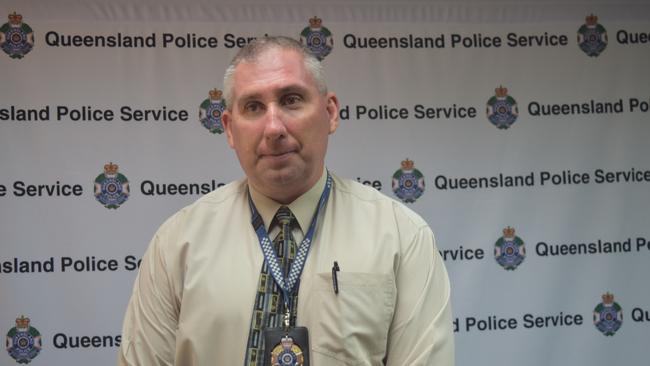YOUTH CRIME: What is really happening on Mackay streets
After a “disgusting” act of violence against a 21yo, Mackay police have spoken out about youth crime in the region

Police & Courts
Don't miss out on the headlines from Police & Courts. Followed categories will be added to My News.
YOUNG offenders are responsible for only about 4 per cent of crimes committed in Mackay.
Allegations about young offenders are rife on social media, sparking a movement to combat youth crime in the region before the situation reaches “Townsville level”.
One commenter said about an alleged attack on a 21-year-old pizza delivery driver: “They’ve watched what’s happening in Townsville and they get away with it so now Mackay will join the queue”.
Another said: “these young defenders should be put in the army boot camp. See how it is to work hard for the things that matter to you. Then smash (their) shit.”
But while the majority of crimes committed by perpetrators under 18 are property related, Detective Acting Inspector Mick Searle said the number of youth who repeatedly committed serious crimes was probably in single digits.
“We’ve done analysis on all of our crime within Mackay, and a very small portion of it overall … is committed by young people,” they said.
“Where that changes a little bit is in regard to specific types of crime.
“The more serious aspects of crime they (youths) are tied up in comes into breaking into houses, the stealing of cars — they are probably more heavily represented than the four per cent in those crime classes, but across the range of crime, it is quite small.
“We have an element of youth who continue to commit serious property crime.”
Insp. Searle said property crimes were often linked to a range of social factors including alcohol and drug dependencies, poor family arrangements and socio-economic circumstances.
“Then there is the other side of it, which is your crime against people, assaults and things like that,” he said.
“The majority of assaults are committed by adult offenders … but there is always an element of young people tied up in that.”
Insp. Searle said the violent crimes were often related to school fights and bullying, or in some cases alcohol or drug-fulled violence at parties and in public places.
“It is not widespread but it does happen,” Insp Searle said.
“They are our main concern — physical crime … and that significant property crime.”
Insp Searle emphasised that despite what might be on social media, youth were not committing “monstrous” amounts of crime.
“They are certainly in the minority, so far as offences being committed in Mackay,” he said.

“The best intervention in crime is the public”
Commenting on the alleged attack on a 21-year-old pizza delivery driver at Slade Point on Tuesday night, Insp. Searle said he believed the community had reacted to it in the way it had because it involved a level of violence not always seen in Mackay.
“I don’t anticipate it is something we will see every night or every week.
“We’re certainly putting a lot of work into that offence for the benefit of that young man and the community so they can feel safe within the area.
“However, once people feel a bit unsafe and something like that strikes a chord with people, in this day and age of social media, it can get whipped up really quickly.
“There are positives to that. People who may not normally choose to provide information on things they might know and things they may have seen come out of the woodwork.”
Insp. Searle said Mackay police has been working with influential community members to encourage people to bring information to the police and not just post it on social media.
He said there had been a lot of discussion on social media and in the Slade Point community about the offence but police were still trying to nail down who the offenders were.

Preventing and dealing with youth crime
POLICE deal with young offenders in several ways under Queensand legislation.
“We will investigate any offence, whether the offender is a young person or an adult,” Insp Searle said.
“The investigation we will go through is largely the same: identify the offenders, try to apprehend them. From that point, things change with regard to young people.”
Police can offer cautions for some offences, use restorative justice or put the young offender before the courts.
“There is a probably a misconception that kids can be given a slap on the wrist and sent out the door. That is not the case. There are some fairly strict guidelines around offering young people a caution and one of them is acknowledging their part in the crime,” Insp Searle said.
In the restorative justice approach, young offenders sit down with the Department of Youth Justice, sometimes a police officer and often the victim.
“That young person then has to sit across the table from these people and face the consequences of what they’ve done,” he said.
“It can be quite confronting for them. Having sat through that process (as a police officer), it can have quite an impact on these young people.
“If a child continues to commit offences, despite being offered and going through those process, we will put them before the court.”
But Insp. Searle said the main aim was to intervene before young people started going down the wrong path.
“Once they are too far in the youth justice system, and are constantly offending and being apprehended and finally end up in custody, once they are going down that path, it can be very difficult for us to retrieve them and put them on the right path,” he said.
“A lot of these kids, their social background, there can be issues at home, issues at school, some of the influences now … can be negative, so there are a lot of these factors that we are trying to get around.”
Insp. Searle said it was very important to not tar all young people in the Mackay region with the same brush.
“The great majority of kids who go through (restorative justice) don’t commit more offences,” he said.
“Our level of recidivism is very low.
“The number of children who actually reoffend after our first interaction … is also very small.
“In the great majority of cases, those other alternative diversionary measures are successful. But some, it’s like anything … it doesn't work for them.”
There are multiple ways to report information to police. You can use Crime Stoppers (1800 333 000) if you wish to remain anonymous, or report via Policelink (13 14 44). Insp Searle said people were also welcome to visit a police station and talk to an officer directly.



